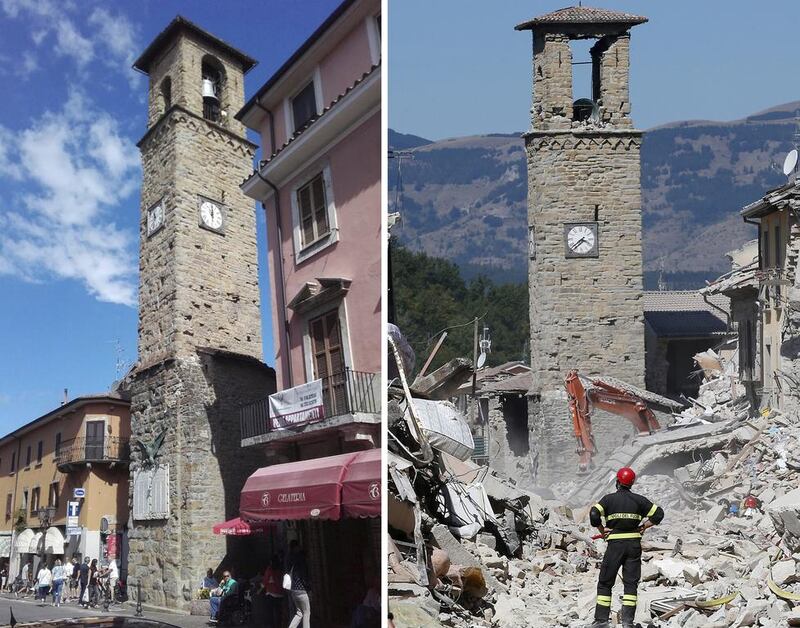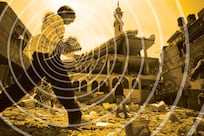The timing and strength of the earthquakes that hit the Italian towns of L’ Aquila in 2009 and Amatrice a month ago were said to be eerily similar. The focus has, however, shifted from forecasting to better protection of people’s lives.
When the residents of Amatrice in central Italy went about their daily lives a month ago, they had no idea they were about to share the fate of a nearby town seven years earlier.
At about 3.30am on August 24, the rock beneath Amatrice ruptured, triggering an earthquake measuring about 6 on the Richter scale.
Equivalent to the detonation of 30 million kilograms of explosives, the seismic energy shook the ancient town, turning buildings to rubble in seconds.
A month on, the death toll stands at about 300, with thousands left homeless.
Yet within hours, reporters were pointing to the “eerie” similarities between the devastation of Amatrice and the fate of the town of L’Aquila, about 50 kilometres to the south.
In April 2009, it too had been struck by a Richter 6 earthquake that had devastated the town, killing about 300 people and leaving thousands homeless. The quake had also struck just after 3.30am.
To any seismologist, this was a set of “coincidences” just waiting to happen. For the rural tranquility of the region is notorious for masking the geological chaos beneath, where colossal slabs of rock have clashed for millions of years.
One such slab is working its way beneath Italy’s Apennine Mountains, propelled by the roiling heat of the Earth’s interior. The result is a chain of geological hot spots along the famous “backbone” of Italy that is especially prone to tremors – or worse.
Last month, it was the turn of the rocks 5 kilometres below Amatrice to break under the strain, just as they had under L’Aquila seven years ago.
There is, however, one difference between the two disasters: glimmerings of a seismic change in attitude about how to avert such calamities.
After the L’Aquila earthquake, the media focused on the age-old question of whether the quake could have been predicted.
For weeks, the town had been rocked by tremors, prompting fear that something much worse was about to strike.
Among seismologists, the significance of such tremors is not clear-cut. Sometimes they do herald a devastating event but more often they just fade away.
Yet during the run-up to the L’Aquila disaster, a local laboratory technician had alarmed many residents by claiming they presaged a major earthquake.
Seismologists were deeply sceptical – not least because no one had ever predicted the time, place and strength of a major quake.
At a meeting in the town, experts declared that the tremors were unlikely to be important but said it was impossible to be sure.
This naturally did little to allay concerns, prompting one official – not a seismologist – to announce that the tremors might have released pent-up energy.
As such, there was probably little to worry about – so little, in fact, that he suggested that people should relax with a glass of local wine.
A week later, the improbable disaster happened and L’Aquila was reduced to rubble.
The team of experts and the official were subsequently arrested and charged with manslaughter.
It was a move that prompted outrage in scientific circles. Officials were accused of turning the experts into scapegoats for a disaster that no one could reliably predict.
Yet this ignored the fact that telling people to go and enjoy a glass of wine is precisely that: a prediction that there was nothing to worry about.
The entire team was convicted and sentenced to six years in jail, although all the scientists were cleared after an appeal. Only the conviction of the official, Bernardo De Bernardinis, was upheld. His sentence was, however, reduced to two years.
Seven years on, the response to the Amatrice quake has been strikingly different – and in a way that holds out hope for the future.
This time there has been no hand-wringing over whether the quake could have been forecast. It seems the constant refrain of seismologists that earthquakes cannot be predicted has finally entered the public consciousness.
Instead, the focus now is on protection – specifically, ensuring that buildings are quake-resistant, and that high-rise dwellers know how best to stay safe.
After the Amatrice quake, reporters pointed to Italy’s notoriously lax enforcement of planning regulations and sloppy building practices. Meanwhile, officials highlighted the low take-up of grants to make buildings more quake resistant.
The Amatrice disaster may prove to be a turning point in attitudes.
A prosecutor has already began investigating claims that many of the casualties were ultimately caused by poor construction, and there is talk of charges of culpable homicide being brought against those responsible.
Ironically, the historic buildings that give such towns their charm have proved the most resilient to the quake.
Proof can be seen in images of the ancient clock tower of Amatrice, standing amid the chaos of the ruined town.
One of many in the area, the 800-year-old structure has been struck at least twice before, yet, like the others, has defied destruction.
Part of the reason is that – unlike some of the far more modern buildings – the tower was built well with high-quality materials. But as a team led by Dr Brendan Duffy, a geophysicist at the University of Melbourne, Australia, report on the website The Conversation, the size and shape of the tower also helps to resist the horizontal and vertical ground movements produced by quakes.
Unlike the sci-fi dream of earthquake prediction, knowing how to exploit such phenomena is a proven life-saver.
When Chile was struck by an 8.8 Richter earthquake in 2010, the final death toll was fewer than 600 lives largely because of quake-resistant construction. In contrast, when a far weaker quake struck the shanty towns of Haiti a few weeks earlier, more than 200,000 people were killed.
But better construction alone will not protect those living in high-risk zones such as central Italy. Regular drills of how to respond to a quake are crucial. People need to know where the safest places in their homes are – away from windows and under tables – and to stay away from outside walls and doorways.
Of the many similarities between the Amatrice and L’Aquila quakes, the fact that they both struck in the early hours of the morning prevented the death tolls from being even higher. Had they struck during day time, the quaint, narrow streets of the towns thronging with people would have become death traps as the walls collapsed.
Whatever the outcome of the investigations, it would be criminal to count on such luck saving lives when the next quake strikes – as one day it surely will.
Robert Matthews is visiting professor of science at Aston University, Birmingham






